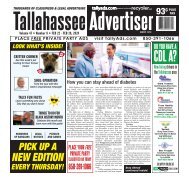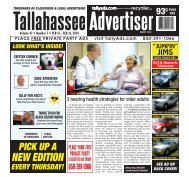TLA65_AllPages
You also want an ePaper? Increase the reach of your titles
YUMPU automatically turns print PDFs into web optimized ePapers that Google loves.
TALKING TCA<br />
Those Who Deliver<br />
with Nussbaum Transportation<br />
By Dwain Hebda<br />
It’s not a particularly novel thing for a company executive to<br />
say investing in people is their company’s primary strategy<br />
for success — but relatively few back up those platitudes<br />
with real action.<br />
That’s not the case at Illinois-based Nussbaum Transportation.<br />
This company has earned a reputation for putting serving<br />
people at the top of the company’s priorities both internally and<br />
externally.<br />
“I don’t want to sound cliché when I say this, but our focus<br />
is really on people, and it shows,” said Brent Nussbaum, second-generation<br />
CEO. “I think if you focus your attention on your<br />
people, your people take care of your customers — and your<br />
customers recognize that, and they bring you more business.”<br />
Nussbaum, who took over as CEO in 2000, says keeping people<br />
foremost in the running of the business has paid off on several important<br />
metrics, not all of which show up directly on a balance sheet.<br />
The company’s turnover rate is low, and morale is high, in part<br />
due to the lengths management goes to communicate regularly<br />
and effectively with the front lines. That behavior is in turn modeled<br />
by employees to the outside world.<br />
“Constant communication with your customer sounds fairly normal,<br />
but you have to evolve your driver into that role,” Nussbaum<br />
said. “You can’t just say, ‘Our people in operations take care of that.’<br />
“Our drivers need to feel like they’re a part of that process,” he explained.<br />
“One of the ways that we keep our people informed — and<br />
this drives everything else — is presence. Every quarter, we’re sharing<br />
our finances with all of our employees, including our drivers.”<br />
Nussbaum encourages employees at all levels to ask questions<br />
and provide valuable feedback.<br />
“We do what we call ‘Dashboard Radio,’” he said. “Every two<br />
weeks, we’ve got a Dashboard Radio program. It might involve<br />
somebody in operations, somebody in maintenance, somebody<br />
in human resources or safety, somebody in recruiting.”<br />
These programs do more than just provide information.<br />
“Drivers are allowed to call in, if they’re sitting still, and be<br />
a part of the conversation and ask questions,” Nussbaum explained.<br />
“That keeps them informed. I’m convinced that an informed<br />
driver wants to do better for their employer.”<br />
This kind of all-for-one buy-in has helped the 79-year-old company<br />
remain nimble in changing times, one of the most existential<br />
examples of which happened when Nussbaum took the reins.<br />
“We grew up in LTL. Up until 2001, LTL was two-thirds of our<br />
business, and the other third was full truckload,” he said. “We<br />
recognized the market was shifting away from LTL toward full<br />
truckload as big-box stores were coming into play back in the late<br />
’90s. When they ordered, they ordered in truckload quantities.<br />
“The one thing that we were always really good at was servicing<br />
our customers on the LTL side — but we realized we couldn’t<br />
survive long-term as a niche LTL carrier,” he continued. “So, we<br />
exited LTL in 2001, downsized the fleet, started over again with a<br />
small truckload fleet, and grew it. Along the way, instead of just<br />
hauling irregular route loads, we began dedicated operations. Today,<br />
about a third of our business is dedicated and a third of our<br />
business is irregular route.”<br />
During the strategy’s build-back phase, company leadership<br />
spotted opportunities that fell between LTL and truckload categories.<br />
They capitalized on those opportunities using logistical<br />
innovation and creative strategy.<br />
“Our focus is going to be on manufacturers that need dedicated<br />
service between their plants,” Nussbaum said. “Sometimes<br />
we found manufacturers or distributors that don’t have<br />
dedicated operations and combined them into what I would call a<br />
semi-dedicated-type operation, where you’re using two one-way<br />
moves (and combining them) into a dedicated-type operation<br />
from two different customers.”<br />
The carrier also hasn’t shied away from adopting new technologies<br />
to help boost efficiencies and streamline operations.<br />
Nussbaum describes these new advancements as one of the biggest<br />
secret weapons in the company’s toolbox.<br />
“I would say the biggest change in transportation today has<br />
been in the growth in information technology,” he said. “Business<br />
analytics have transformed our business to drive more informed,<br />
quicker decisions, which drives greater productivity and efficiency.<br />
“We’ve got a huge IT department, and we build a lot of our own<br />
solutions. We are constantly using the data to help us to drill down<br />
into our costs and that’s another big piece,” he continued. “The<br />
28 Truckload Authority | www.Truckload.org TCA MARCH/APRIL 2024
















